Bannerghatta National Park in Bengaluru, Karnataka, is where scores of species find a safe and secure home. Within this sanctuary lies the Wildlife SOS Bannerghatta Bear Rescue Centre (BBRC), a dedicated shelter for rescued sloth bears. Common to both are those that cross trees and the meandering stream with their ability and freedom to fly. Let’s introduce you to the birds of Bannerghatta, captured through the eyes (and camera lenses!) of our staff, visitors and volunteers. This is part I of a series of three articles.
We all know birds as flying beings flitting from tree to tree. For the lucky ones, birds are their wake up call (!) every morning. But here’s a fact that may leave you gobsmacked — birds are the only living dinosaurs around us. It’s true! The birds we see today are the descendents of theropods that lived over 150 million years ago. While towering reptiles and toothy predators of their world became extinct, birds survived, evolved and adapted.
And what better place to spot them than at the Wildlife SOS’s Bannerghatta Bear Rescue Centre (BBRC)! Here, rescued sloth bears live in peaceful rehabilitation, and if you tune in all your senses, you’ll note that the air is filled with the soft flutter of wings and the cheerful calls of over 30 bird species. With native trees, quiet ponds, and a minimal human footprint, BBRC offers just the kind of habitat birds love — a mosaic of food, water, and nesting spots. Here, they don’t just pass through — they stay, they thrive, and they fill the forest with songs. From the emerald flash of a common iora to the haunting gaze of a spotted owlet, each bird at BBRC plays a unique and vital role in the ecosystem.
So keep your binoculars ready as we take you on a journey to find these 10 beautiful birds at BBRC!
1. Yellow‑crowned woodpecker
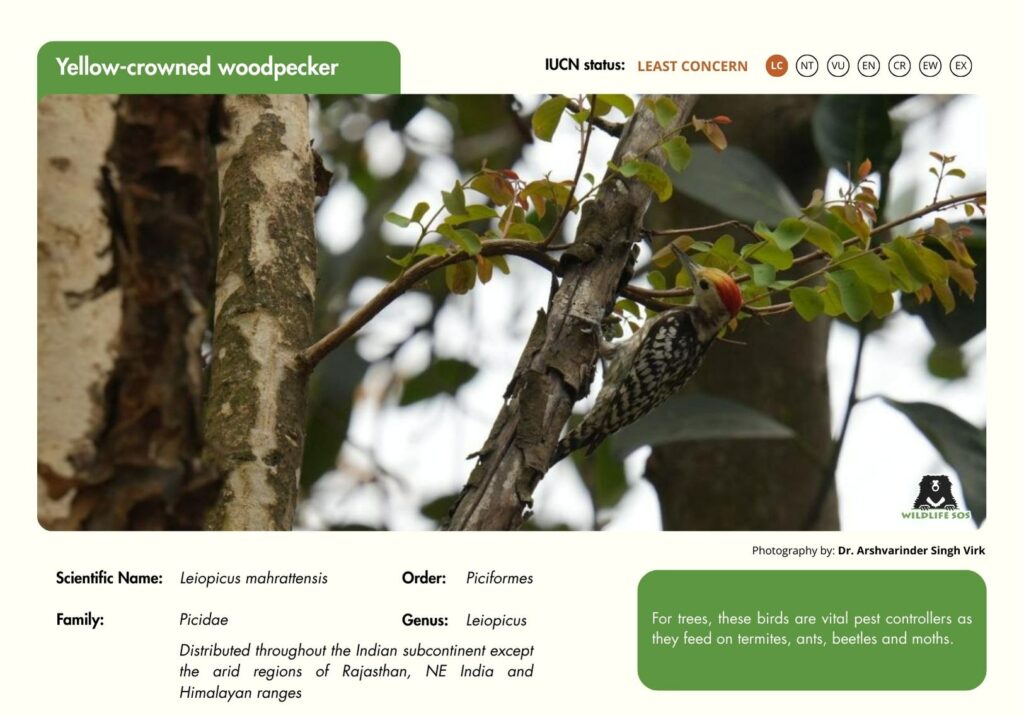
Imagine a bird wearing a smart polka-dotted jacket! This medium-sized woodpecker wears black-and-white spots on its back and a patchy mix of brown and white on its belly. If you look closely: the lady sports a golden crown, while the gentleman adds a splash of red to his forehead.
- The yellow-crowned woodpecker can be praised as nature’s very own tiny carpenter — it pecks repetitively onto the bark of a tree while climbing it up or down, with a “tap-tap-tap” sound that resembles nothing less than a hammer knocking a nail!
- These tree-tapping wonders are always on the lookout for tasty insects hidden in barks or branches! While they primarily dine on ants, termites, beetles, moths, and caterpillars, they also enjoy juicy fruits like figs, and sip nectar from flowers such as Bombax ceiba (silk cotton tree) and Erythrina variegata (Indian coral tree).
- Their tongue is no less than a magic tool! It’s long, sticky, and barbed, perfect for fishing out sneaky insects deep inside trees.
- Yellow-crowned woodpeckers are also house builders for their wild community — they create tree holes for nesting, and once they abandon them, these serve as cosy homes for owls, parrots, squirrels, and many more creatures of the forest.
- It was earlier assumed that constant pecks on tree barks was because woodpecker skulls are mini shock absorbers — but a 2022 study revealed that their skulls don’t cushion impact like a helmet would. Woodpeckers rely on their small, tightly packed brains, specialised beak structure, and strong, spongy bones to distribute the force of pecking efficiently. Rather than absorbing shock, their anatomy helps them withstand and manage it.
2. White‑cheeked barbet
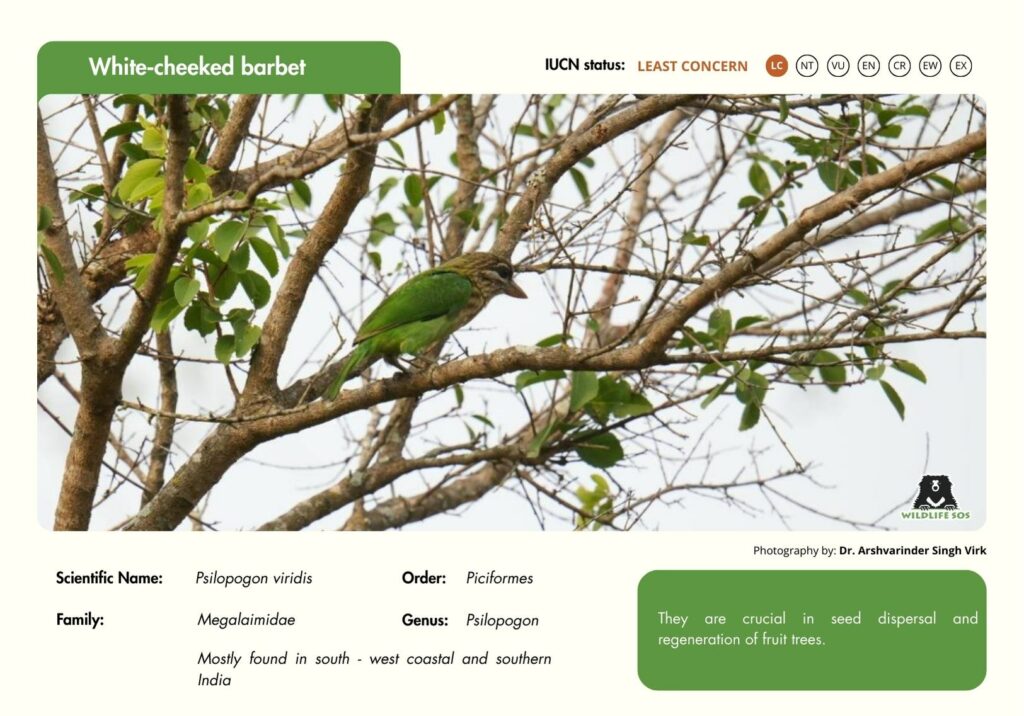
If you spot a plump green bird with a chocolate-brown head and a white stripe below its eye, you’ve likely found the white-cheeked barbet — South India’s very own fruit-loving chatterbox! Look for its a pale line above the eye (called a supercilium), and a throat streaked with white.
- Much like their barbet cousins across Asia, the white-cheeked barbet’s leafy green plumage, upright posture, and stillness help them blend seamlessly into the canopy, making them a challenge to spot.
- Their vocal call begins with a deep, rolling “trrr” followed by a repetitive “Kot-roo… Ko-troo…”, which can sound quite similar to the call of a brown-headed barbet.
- White-cheeked barbets are primarily frugivorous, consuming fruits of ficus species like Ficus benjamina and Ficus mysorensis that are found in BBRC as well. They may consume insects too.
- Its territoriality when it comes to eating fruit influences the feeding habits of other frugivorous avians.
3. White‑browed Bulbul
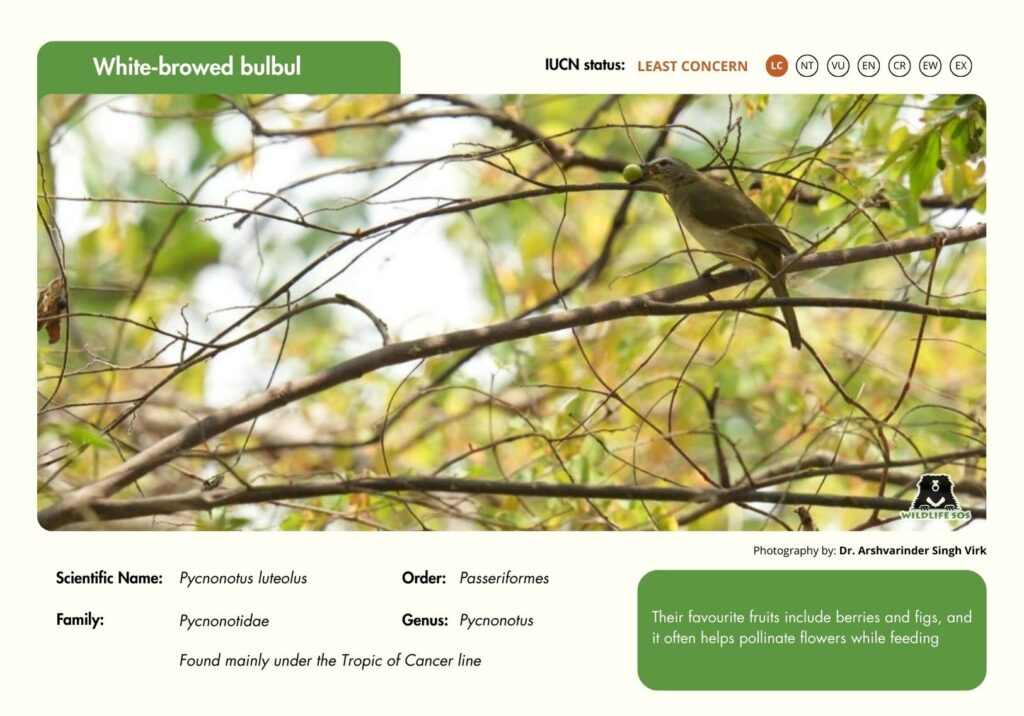
The bright white supercilium gives this bulbul its name, but interestingly, it has a white crescent below its eye as well. The bird has a dark stripe across the eye, a moustache mark extending from the beak, a whitish-grey forehead and an olive brown body — but because it is very shy, this bulbul is a hard one to spot! But if and when you do, a striking colour it wears is waiting to be seen: a splash of yellow on the chin, and even under its tail.
- The white-browed bulbul’s call sounds like a loud chitter-chatter! Sometimes they’re sharp notes of “wheek-wheek woo” and sometimes, a low but raspy churr. It often sings hidden among branches, making its song easier to find than the bird itself.
- This bulbul loves a mixed platter of food — it munches on fruits, seeds, insects, and even nectar. It hops through shrubs and low trees, peeking under leaves and foraging on the ground.
- Both male and female white-browed bulbuls look alike. They tend to remain hidden low in the dense growth of bushes, making sure to keep birdwatchers wait for a while before flying to the top!
4. Indian Paradise Flycatcher
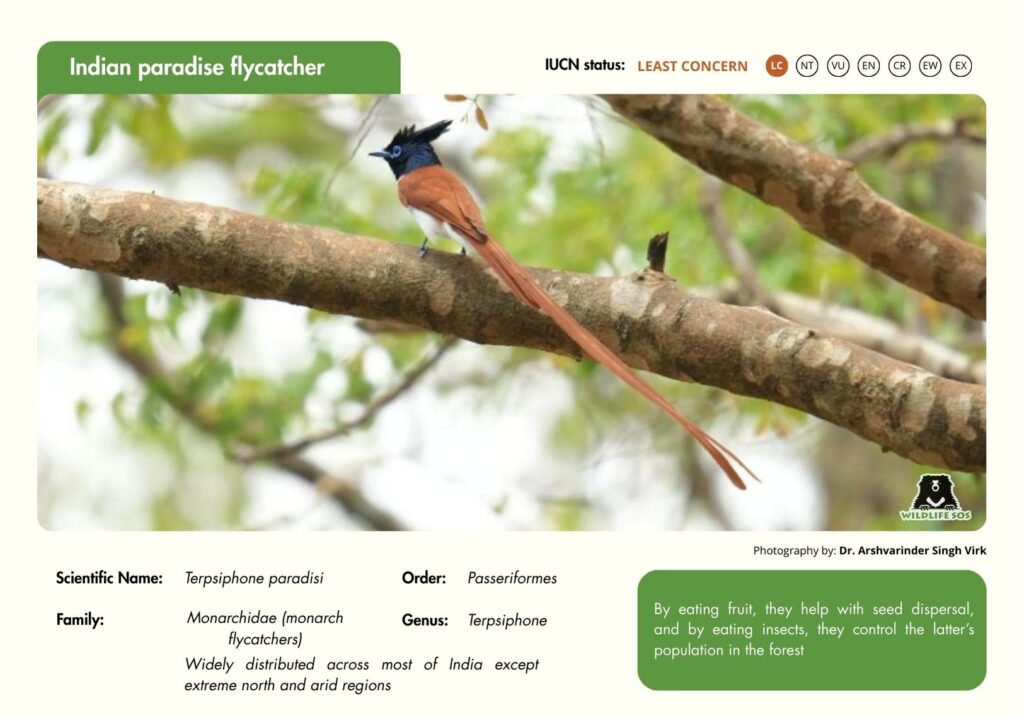
With a name as ethereal as its looks, the Indian paradise flycatcher is one of the most elegant birds you’ll spot at BBRC! Adult males are especially eye-catching with their long, ribbon-like tails that flow behind them like a streamer in flight. They can appear in two morphs — one having a rich cinnamon brown back and tail, and the other a dazzling white. Both variants have glossy black heads and crests, and a bright blue ring around their eyes. The females are cinnamon-coloured too but have shorter tails, greyish throats, and lack the blue eye-ring.
- Their call carries a crisp ‘shreew’ — but their song is quite sharp, yet musical.
- True to their name, these flycatchers are expert insect hunters zooming through the air to catch hold of dragonflies, butterflies, beetles, and other flying insects. They also eat fruit like berries.
- Indian paradise flycatchers living in colder areas migrate to warmer forests during the winter. But how do they find their way? They use magnetoreception — which is nothing less than a superpower that lets them sense the Earth’s magnetic field as their own GPS!
5. Greenish Warbler
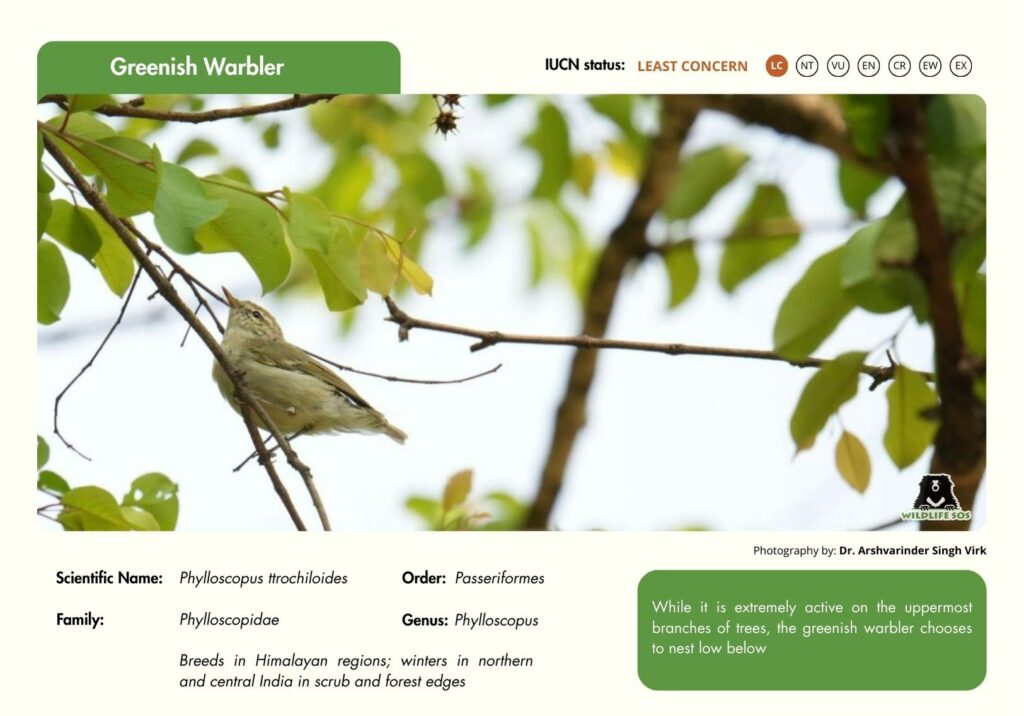
Greenish warbler is a tiny bird that blends into tree canopies with its dull green upperparts and pale underparts. It has a bold white eyebrow across the forehead and brown legs.
- Often heard but hard to spot, its song is a high-pitched cascade of melodic phrases that eBird, a popular online database of birds, cites as: “tsit-psityee psityu-psi-ti-ti-ti-ti-si”.
- Despite its petite size, this warbler is mighty enough to travel great distances — it takes a non-stop flight over the towering Himalayas during migration! They are what is known as a “ring species” around the Tibetan Plateau. A ring species is one that spreads across two pathways around a geographical range, evolving their behaviour according to their surroundings — so much so, that when the same species from differing environments come across one another, they consider the other as being a separate species. Changes in their song and behaviour have caused the same birds to not interbreed with the other. This makes greenish warblers exceptional in nature!
This warbler is an insect-hunting machine! It snacks on a wide variety of invertebrates — grasshoppers, beetles, moths, flies, spiders, mites, and even tiny molluscs. Occasionally, it also nibbles on small seeds.
6. Oriental Magpie-robin
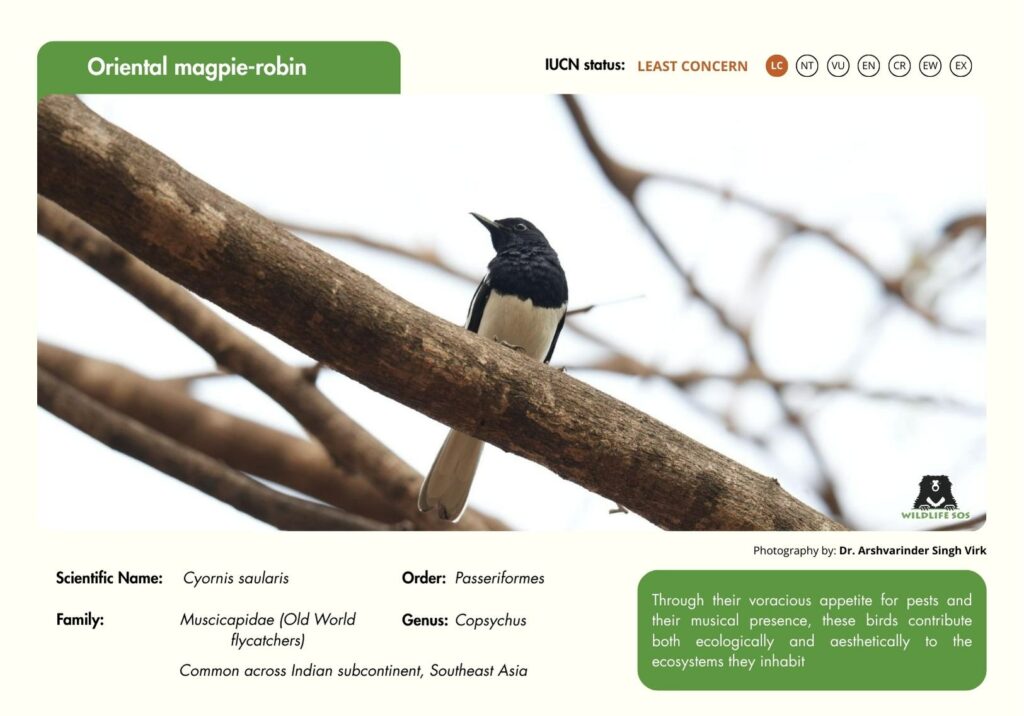
A medium-sized bird, the oriental magpie-robin is easily identified by the broad white wingbar stretching from shoulder to the tip of the wing and its bold black-and-white tail feathers, particularly noticeable in flight. Males are dressed in a blue-black coat that shines like velvet, while females sport a subtler greyish-brown upper body. Juveniles resemble the females, but have scaly patterns on the head and upperparts.
- These charismatic songbirds are one of the most melodious birds that sing long, clear and composed tunes. When they experience territorial threat or distress, they emit a sharp “churr churr” several times. They are also known to mimic calls of other birds.
- Indian magpie-robins tend to flick and fan their cocked tails while strutting, often to fiercely guard their territories.
Their diet is primarily insectivorous as they feast on worms, insects, and other invertebrates from the ground in gardens, woodlands, and city parks.
7. Tickell’s Blue Flycatcher
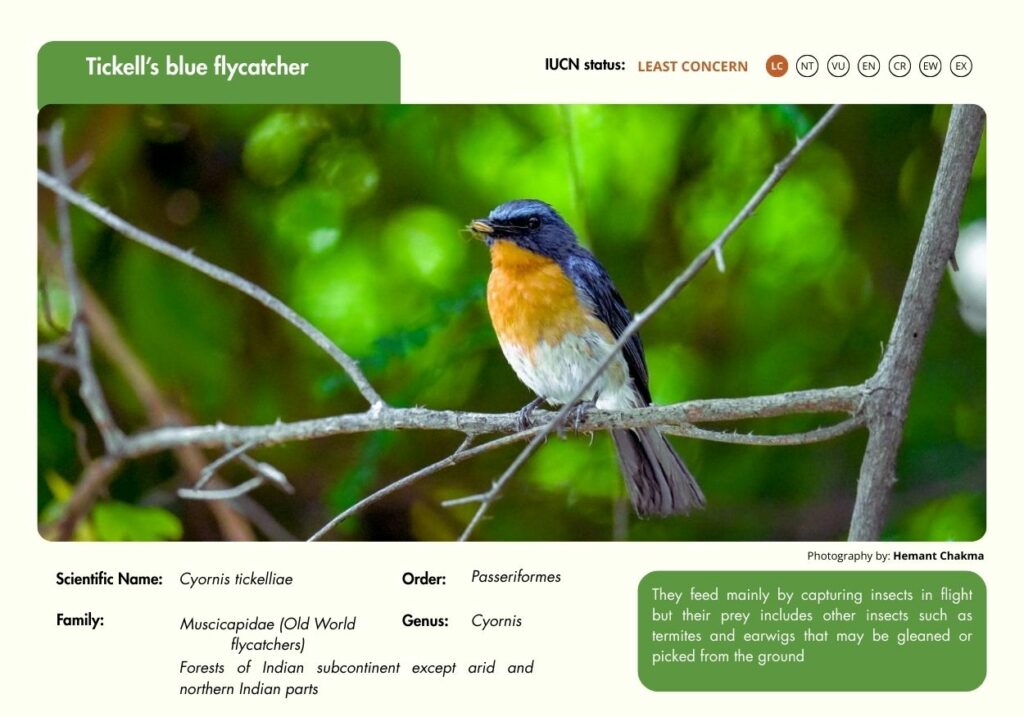
This vivid small bird has a brilliant sapphire-blue back, a burst of warm orange spreading from its throat to its chest, and continuing with a contrasting white underbelly. Males wear richer, more saturated hues than females, who appear more subtly toned. However, this flycatcher is often confused for resembling its look-alike cousins, blue-throated blue flycatcher and the hill blue flycatcher. To distinguish between them, the Tickell’s blue flycatcher has a neater coloration with lesser orange overall when compared to the hill blue flycatcher, and a deep orange glow on its throat sets it apart from the blue-throated flycatcher.
- When it’s time to raise a family, both parents tend to the nestlings in a nest constructed out of fibres and leaves of bamboo and other plants.
- Home sweet home for these birds are in the drier areas near water bodies, where they can find a buffet of insects to feed on as well. In its hunting technique, it zips through the air to catch hold of flying insects, and sometimes, even hops down to the foliage to pick them up.
Tickell’s blue flycatcher might be a little bird, but its voice is grand! It lets out a series of clear, tinkling metallic notes, which break into sharp “churr” calls when alarmed. You might even hear its curious medley of rapid clinks and clicks that sound like it’s beatboxing in the undergrowth!
8. Common Iora
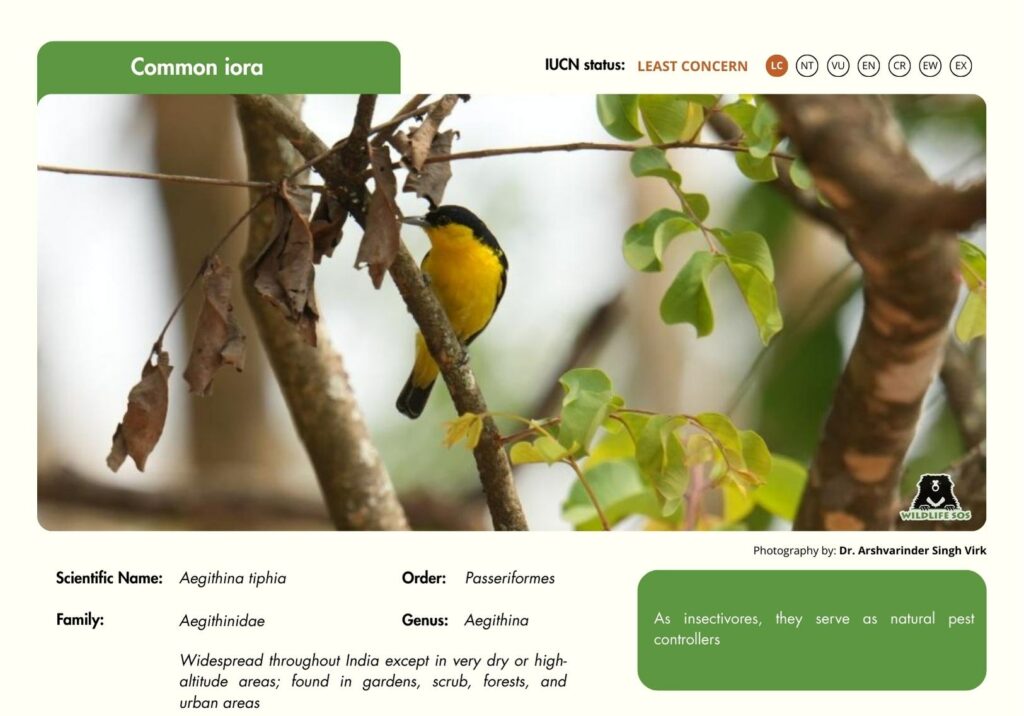
The common iora is a vibrant little bird that packs quite a punch in both colour and personality. When they are ready to mate, males don black upperparts set off by crisp white wing bars, and a bright yellow underbody . Outside the breeding season, they have a more subdued greenish-yellow coat that resembles the females.
- Lively yet nimble, the common iora hunts for insects such as caterpillars and spiders on trees. It does so by searching for them on the undersides of leaves, or by twisting and turning within branches — sometimes even hanging upside down on them with acrobatic finesse!
- Their wonderful vocalisations range from a whistling “twiii tuiii twiiii” to chatters and trills of “wheeeee-tee”.
Both male and female ioras incubate the eggs in nests that they construct by weaving cobwebs together in dense foliage. They carefully sneak in and out of it to avoid drawing the attention of any predator to their offspring.
9. River Tern
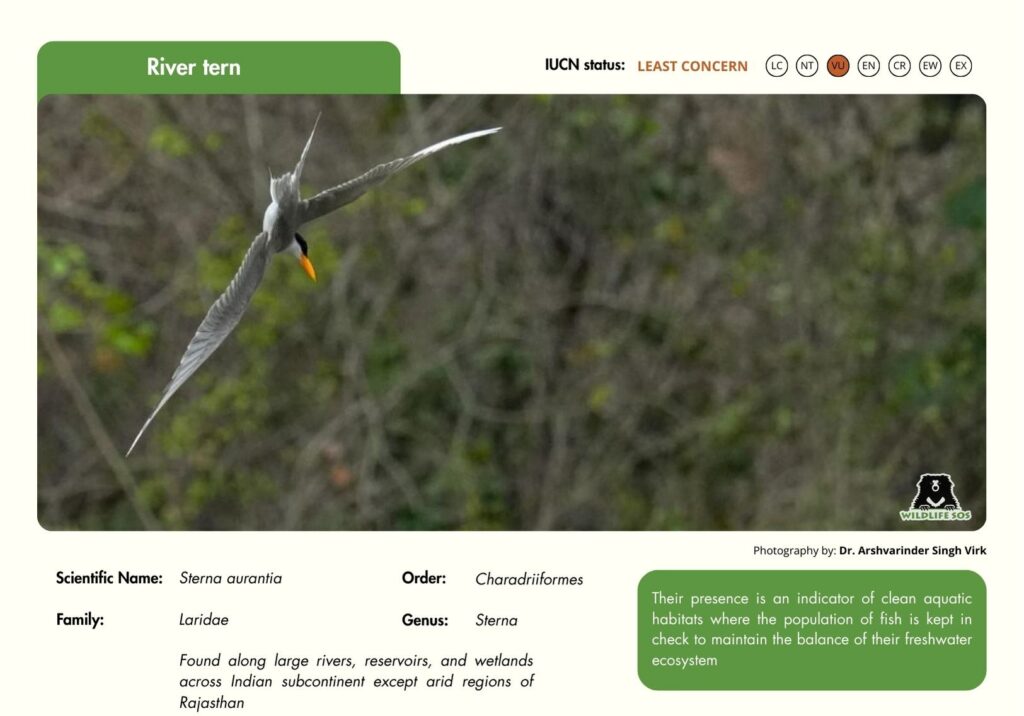
A graceful, medium-sized bird, the river tern has grey upperparts, white underparts, and a long, deeply forked tail. Its bright yellow bill and red legs make it a fascinating bird to spot, even in flight. During the breeding season, it wears a bold black cap, while in winter, which is the non-breeding season, this fades to patches of grey with a dark eye stripe. Juveniles differ with brown-streaked grey upperparts and a brown head.
- River terns rely on sandy or rocky riverbanks for nesting. Every summer, thousands of river terns arrive at the Bhadra reservoir in Karnataka to lay eggs directly on open, sandy islets that are exposed by receding water. This unique ground-nesting behavior helps protect their vulnerable chicks from most predators, making these temporary islands a safe haven during the breeding season. On the flipside, riverbanks are also prone to flooding and human disturbance, and those close to dams can face unpredictable misery.
- River terns prefer flying low over rivers and lakes in circling patterns, and with wings folded tight, they plunge dramatically into the water to catch prey. Primarily piscivorous, they are agile hunters that thrive in freshwater ecosystems, feeding mainly on fish, but also consuming crustaceans, tadpoles, and aquatic insects.
- Their noisy calls include “krree” notes that are sharp, short and often repeated.
10. Asian Green Bee‑eater
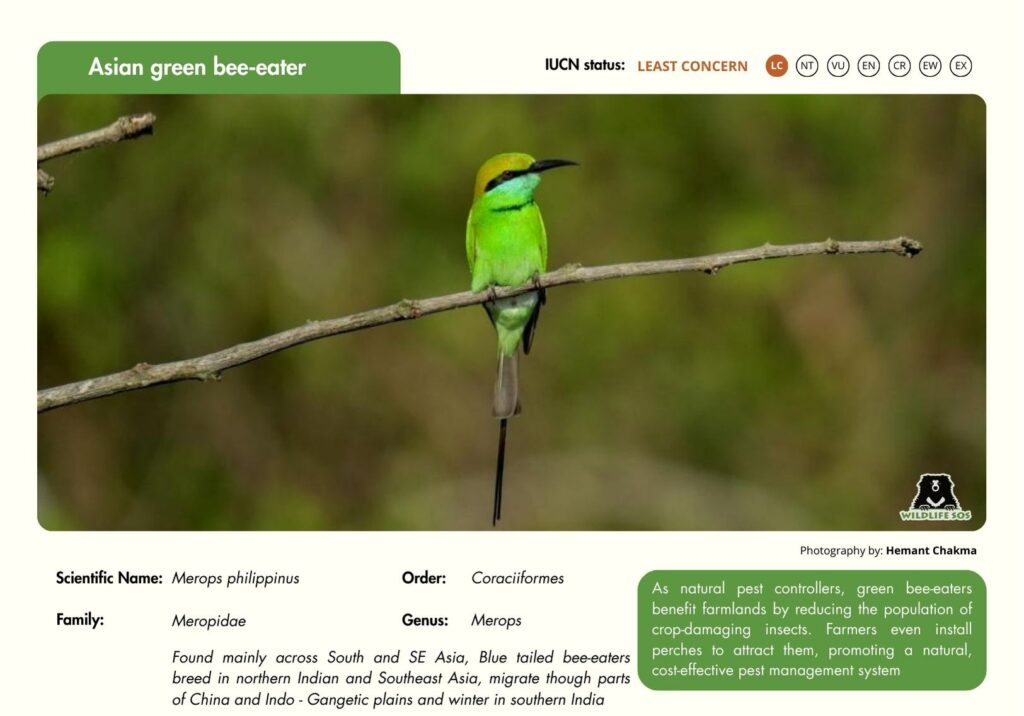
An emerald-green plumage, a bluish throat, rufous crown and nape, black eye-stripe, and streamers emerging from its tail — this is the vividly coloured green bee-eater. The distinctive black gorget (throat band) adds to its charm. Males tend to be brighter than females, while juveniles appear duller, lacking the extended tail and dark gorget.
- This species practices cooperative breeding — males enlist “helpers” in their group to assist with feeding and guarding the nestlings, enhancing chick survival.
- Living in large flocks, these Asian green bee-eaters communicate using short, sharp “tic” alarm calls and soft, trilling “trree-trree-trree” notes. They use them for location tracking and predator alerts.
- Highly skilled aerial insectivores, their strong vision helps them to feed on bees (of course) as well as beetles, butterflies, dragonflies, and grasshoppers. They catch prey mid-flight, then return to a perch to beat the insect against the branch to remove stingers, after which the prey is tossed up and swallowed in whole.
At Wildlife SOS, we believe that the joy of discovery is meant to be shared. If you’re an avid birder, a nature lover, or someone looking to reconnect with the wild, we warmly invite you to visit BBRC or volunteer alongside our team to explore the wonderful wildlife that coexists with our very own rescued sloth bears.
Feature Image © Wildlife SOS/ Hemant Chakma
Sources:
Wildlife SOS Bannerghatta Bear Rescue Centre (BBRC)
Ebird.org






